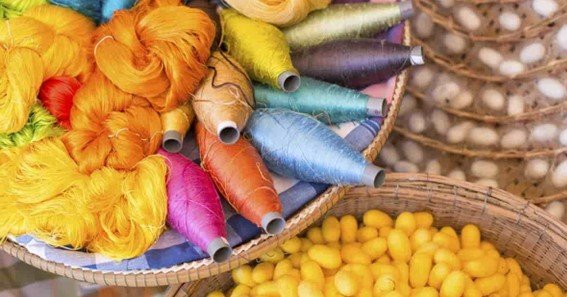Are you curious to know what is artificial silk? You have come to the right place as I am going to tell you everything about artificial silk in a very simple explanation. Without further discussion let’s begin to know what is artificial silk?
The allure of silk has captivated civilizations for centuries, symbolizing luxury, elegance, and refinement. However, the intricate process of producing natural silk involves silkworms and careful cultivation, making it a resource-intensive endeavor. Enter artificial silk, a remarkable innovation that offers the same lustrous appearance and smooth texture as natural silk while providing a sustainable alternative. In this blog, we will explore the fascinating world of artificial silk, its creation, properties, and the role it plays in both fashion and sustainability.
What Is Artificial Silk?
Artificial silk, also known as synthetic silk or faux silk, is a fabric that mimics the luxurious qualities of natural silk without relying on the traditional silkworm-based production process. It is created using synthetic fibers that are carefully engineered to replicate the smoothness, sheen, and drape of real silk. Artificial silk provides an accessible and eco-friendly option for those who desire the elegance of silk without the ethical or environmental concerns associated with traditional silk production.
The Creation Of Artificial Silk
Artificial silk is typically produced using two main types of synthetic fibers:
- Rayon (Viscose): Rayon is a regenerated cellulose fiber derived from wood pulp. It is processed and chemically treated to create a silk-like fiber. The resulting fabric, known as rayon or viscose, closely resembles natural silk in terms of texture and drape.
- Polyester: Polyester is a synthetic polymer fiber that can be finely woven to create a fabric with a soft feel and subtle sheen, similar to natural silk. Polyester-based artificial silk is known for its durability and resistance to wrinkles.
Properties Of Artificial Silk
- Lustrous Appearance: Artificial silk boasts a captivating sheen that closely resembles the gloss of natural silk, adding a touch of luxury to any garment or textile.
- Smooth Texture: Just like natural silk, artificial silk has a smooth and soft texture that feels gentle against the skin, making it a popular choice for clothing, lingerie, and accessories.
- Drape and Flow: The fabric’s excellent draping characteristics allow it to flow gracefully and elegantly, creating stunning silhouettes and enhancing the overall aesthetic.
- Breathability: Artificial silk, particularly rayon, offers breathability and moisture-wicking properties, ensuring comfort even in warm and humid conditions.
- Versatility: Artificial silk is incredibly versatile and can be used for a wide range of clothing and accessories, including dresses, blouses, scarves, and even home textiles.
The Role Of Artificial Silk In Sustainability
Artificial silk contributes to sustainability in several ways:
- Reduced Environmental Impact: The production of artificial silk requires fewer natural resources and has a lower environmental footprint compared to traditional silk production.
- No Animal Exploitation: Unlike natural silk, which involves the harvesting of silkworms, artificial silk is cruelty-free and aligns with ethical considerations.
- Innovative Manufacturing: The production of artificial silk utilizes advanced manufacturing techniques that promote resource efficiency and waste reduction.
Conclusion
Artificial silk is a testament to the fusion of scientific ingenuity and aesthetic elegance. By offering a sustainable alternative to traditional silk, it addresses environmental concerns and ethical considerations while providing a fabric that exudes opulence and grace. As fashion and design continue to evolve, the allure of artificial silk stands as a testament to our ability to combine innovation and beauty to create fabrics that not only enhance our lives but also contribute positively to the planet.
On GetDailyBuzz you will get to know beneficial information which required in your daily life.
FAQ
What Is Artificial Silk Class 8?
Fibre obtained by chemically treating woodpulp is called rayon or artificial silk. rayon cannot be called a natural fibre as it is man-made. since it is prepared artificially & posses properties similar to that of silk , it iscalled as artificial silk.
What Is Artificial Silk For Class 7?
Rayon is the name used at the place of artificial silk. Bamboo silk which is made out of bamboo viscous is also sometimes referred to as artificial silk. The fiber that can be made from the natural sources of cellulose, such as wood or some agricultural products known as Rayon.
What Is Artificial Silk Made Of?
Artificial silk or rayon is made up of cellulose, which is obtained from cotton or wood pulp the cellulose is made to dissolve in a substance called alkaline carbon disulphide to make a thick liquid. This is then made to flow from the tiny holes into a bath of acid.
What Is Known As Artificial Silk?
Rayon is a synthetic fibre manufactured from the cellulose of wood pulp or cotton. They possess the feel and texture as of natural silk. Hence, rayon is also known as artificial silk.
I Have Covered All The Following Queries And Topics In The Above Article
What Is Artificial Silk
What Is The Other Name For Artificial Silk
What Is The Other Name Of Artificial Silk
What Is Known As Artificial Silk
What Is Artificial Silk Class 8
What Is Artificial Silk For Class 8
What Is Called Artificial Silk
What Is The Artificial Silk
What Is The Difference Between Natural Silk And Artificial Silk
What Is The Another Name Of Artificial Silk
What Is The Other Name For Artificial Silk?
What Is The Name Of Artificial Silk
What Is An Artificial Silk
What Is Artificial Silk Called
What Is Artificial Silk
What is artificial silk?

